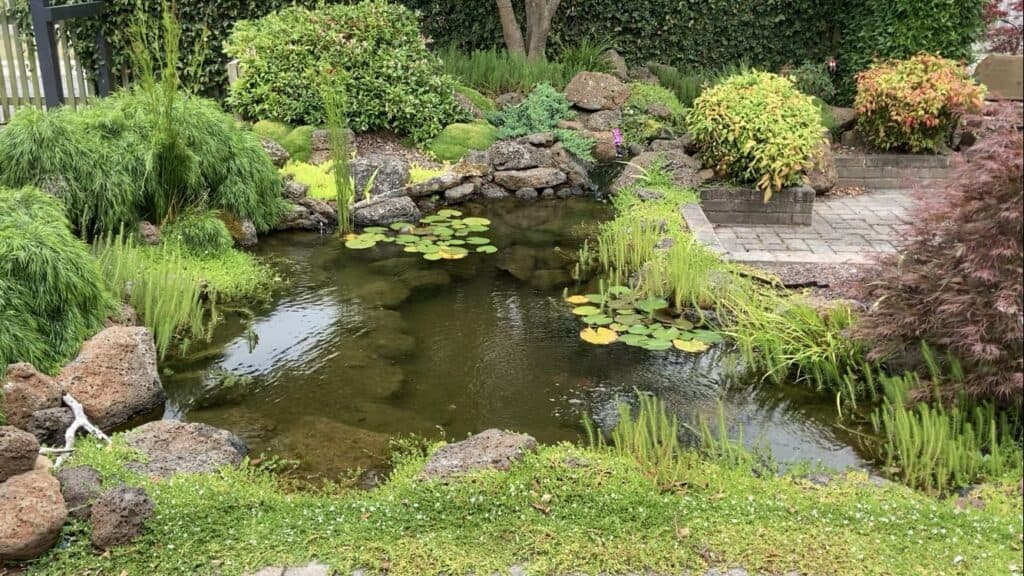String algae can be one stubborn bugger in a backyard pond. So I decided to run a little home experiment to test out different algae control methods — all using water from my own courtyard pond.
And yes, I raided Mrs OzPond’s pantry for jars…
But before we dive into the results, a quick heads-up: if you’re new here, I’m Kev, and I help people build and maintain ponds without spending a fortune.
If you want to learn how to do that you’ll love my free newsletter.
🧪 The Algae Experiment Setup
I filled 9 jars with pond water from a well-established 6-year-old pond and added the same amount of stubborn string/hair algae to each. Then I tested these 8 methods:
- Control (no treatment)
- Shade
- Plants (Hornwort + Red Root Floater)
- Substrate from a mature pond
- Shrimp
- Liquid Bacteria
- Diatoms (via a product called diatomix)
- Sodium Percarbonate
- Copper-Based Algaecide
Each jar sat on a kitchen windowsill with good light but no direct sun, except one that I moved to deep shade.
You can find links on where to buy these products by clicking this link. Then, scroll down to the water treatments section.
🌱 What I Expected
- Some of these I was skeptical about (like shade and liquid bacteria).
- Others — like plants and sodium percarbonate — I had higher hopes for.
🔍 Day-by-Day Observations
Day 1
- Copper algaecide jar already looked bleached.
- Sodium percarbonate jar was full of oxygen bubbles — but the algae wasn’t dying yet.
- Bacteria and shrimp jars showed signs of activity.
- All others: no change.
Day 3
- Plant jar: Algae was basically disintegrating. Hornwort seems to live up to the hype.
- Bacteria jar: Algae shrinking.
- Sodium percarbonate: Starting to break down algae.
- Algaecide: Algae was brown and dead-looking.
- Others: not much change.
Day 6
- Sodium percarbonate: Water clear. Algae gone.
- Plants: No string algae left — just fine powder.
- Algaecide: Algae dead but still intact (no breakdown happening).
- Control: Starting to grow new algae.
- Substrate, shrimp, diatoms: Maybe slight improvement, but very slow.
If you would like to watch a video on this experiment, here it is:
✅ What Worked Best?
Here’s how they stacked up:
| Method | Effectiveness | Notes |
|---|---|---|
| Sodium Percarbonate | ⭐⭐⭐⭐⭐ | Completely cleared algae. Oxidizer. Quick action. |
| Plants (Hornwort) | ⭐⭐⭐⭐⭐ | Very effective, natural, and safe. Cleared the jar by day 6. |
| Bacteria | ⭐⭐⭐⭐⭐ | Slower start, but after two weeks it cleared the algae almost completely. Excellent long-term solution. |
| Algaecide (Copper) | ⭐⭐⭐⭐☆ | Effective but toxic to pond life — snails, shrimp, and other critters. |
| Diatoms | ⭐⭐☆☆☆ | Some slight improvement, but nothing dramatic. |
| Shrimp | ⭐⭐☆☆☆ | Possibly helped, but couldn’t keep up. |
| Substrate | ⭐☆☆☆☆ | Small effect over time. Needs more conditions to thrive. |
| Shade | ⭐☆☆☆☆ | Prevented new growth but didn’t reduce existing algae. |
| Control | ☆☆☆☆☆ | Business as usual — algae was still partying. |
If you would like to try sodium percarbonate in your pond you should watch this video first:
🧪 Update on Bacteria Treatment
While it didn’t show dramatic changes during the first few days, by the two-week mark, the jar treated with liquid bacteria had cleared up significantly.
The algae had broken down and the water was much clearer — showing that bacteria-based treatments may take longer to work, but can be very effective over time.
🧠 Final Thoughts
Sodium percarbonate was — fast, effective, and it literally vaporised the algae.
Plants like hornwort also did an amazing job, plus they’re safe for all pond life.
Copper-based algaecide worked too, but it’s not something I will use in my ponds due to its impact on snails, shrimp, and other small creatures.
That said, the long game in any pond is balance — substrate, plants, animals, and good biological filtration (like a bog filter).
Over time, this setup creates a self-sustaining ecosystem where algae struggles to take over.
💡 Want a Pond That Looks After Itself?
Grab my Pond Formulas Blueprint — it’s the same guide I use to design natural filtration systems for crystal-clear, low-maintenance ponds.

Join my free email list
If you would like to join my free email list click the button below.
I promise I won’t spam you, I’ll only send information I think can help you save money building and maintaining a pond.

